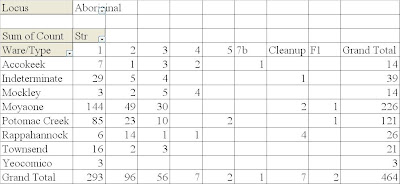 Aboriginal Locus. To refresh your memory, think of the excavation area closest to the court house...or just take a look at this photo of the massive brick rubble feature. This photo is actually of Unit 14 which was excavated during the 2008 Field Session, though there was still plenty of brick rubble to go around this year as well.
Aboriginal Locus. To refresh your memory, think of the excavation area closest to the court house...or just take a look at this photo of the massive brick rubble feature. This photo is actually of Unit 14 which was excavated during the 2008 Field Session, though there was still plenty of brick rubble to go around this year as well.Putting together the section of the report for the Aboriginal Locus has involved a lot of drafting of units and profiles, a job that Pete has diligently worked on and recently completed. I have been working predominately on artifact analysis, which includes going through the catalog to make sense out of our finds in this area from this year and last. Analyzing the aboriginal pottery has been a large part of this task, as you probably know since in the last couple weeks I have bombarded you all with blogs about aboriginal pottery. Well, I figured today should be no different...except instead of talk of temper and snapshots of sherds I am posting a table (below) of the quantity of different types of aboriginal pottery (which you all know so well by now) found in the different strata in the Aboriginal Locus. With these data we can build on prior analyses of the aboriginal component at Port Tobacco.

Another aspect of the report will be our discussion of soil colors and textures. Hopefully we will be able to grasp how the stratigraphy in this particular area formed, or at least obtain a better understanding of the processes affecting the soils (aside from plowing).
Still, do not be fooled by this post's emphasis on aboriginal artifacts! A significant amount of historical artifacts and ceramics were also found at this locus ("only" 8,081 sherds of ceramics over the course of two years...). Many of these artifacts came out of the plow zone, but the historic element is still necessary and important to consider when compiling the report on this locus. After all, it is called the Aboriginal Locus because of the density of aboriginal artifacts found there, not because we are 100% certain that there is an intact aboriginal site in that area.
So, while tables may not be as impressive as photographs, they are crucially important in putting together a report. Plus, it is helpful for getting a better sense of exactly what we found and where.
Kelley























